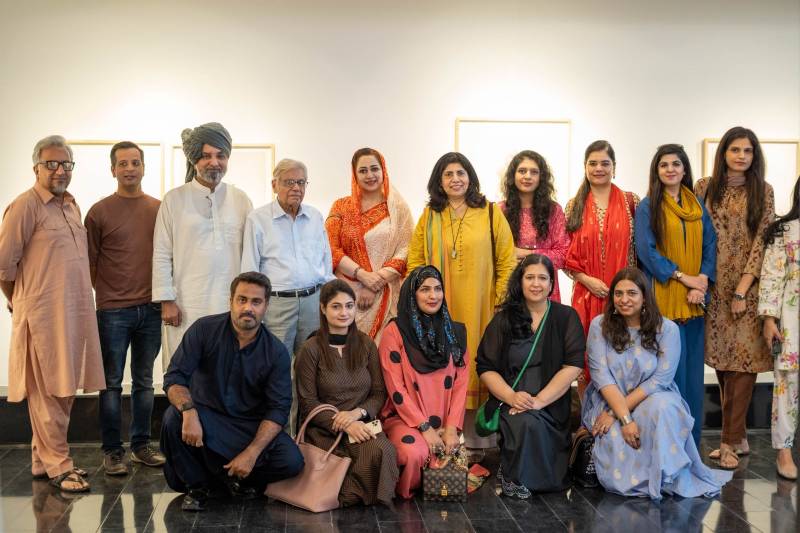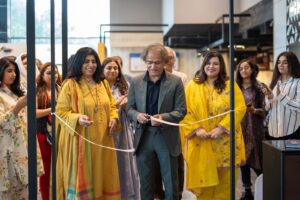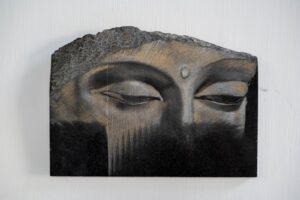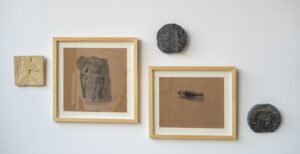
Bodhisattvas may be represented as deities that can be considered equivalent to Buddha in knowledge. Interestingly some visual manifestations of these bodhisattvas have no gender at all while others such as in the Far East have fused with local traditions and folklore so that they resemble beautiful female divinities who are worshipped for their compassion, ability to sacrifice and grant children.
So pronounced is this feminisation of bodhisattvas that their characteristics have even been compared to the Virgin Mary. Perhaps geography, the movement of people, goods and resultant cross-fertilisation of ideas across regions has helped inform the gender and varied physiognomies of Bodhisattvas in sculpture.
Curated by Mariam Hanif Khan, Sumera Jawad's latest solo exhibition titled “I am the Miracle” held at ArtSoch Contemporary, Lahore acknowledges this complex understanding of gender and the rich female representation in ancient religions, particularly in Buddhism.
Unfortunately Jawad's countless trips to the ancient Gandhara site of Taxila have also helped her identify a lacuna: in practice and in scholarship particularly at Taxila, one finds that there is a lack of female figurative depiction in both sculpture and relief as compared to the male figure.

In her artist statement Jawad explains this disjuncture by suggesting that "previous scholarship on women's involvement in Buddhism in the medieval sub-continent assumes that women disappeared from the scene by the ninth century. this view" she writes "may be rooted in our way of seeing (or not seeing) than in the actual historical reality.”
In response to this absence Jawad presents 23 works of art that highlight this gap and reimagine the role and existence of the female body in the ancient civilization. Her graphite drawings on paper show a young girl in various postures and poses of meditation that are similar to those of Buddha depicted in Gandhara art.
Interestingly Jawad's female forms are much more naturalistic. Unlike the tropes of stylisation common to Buddhist sculpture such as flowing robes or elongated ears- Jawad's female form represents a meticulous study of human anatomy rooted in a realism that ascribes to a western understanding of the human body.
Jawad also replaces the period's clothes and ornaments with a representation of everyday life and material culture. Her female form might mimic the cross legged pose of Buddha such as in "Maple Leaf "or the iconography of Buddhist sculpture such as in "The Miracle" which consists of a frontal portrait typified by closed eyes and framed in a golden halo but aside from that there is little that references the past.

Set against a plain background, dressed comfortably in a T shirt, loose baggy pants and adorned in minimal jewellery, Jawad's female with her distinct South Asian physiognomy is an embodiment of the modern, urbane and even global.
Historically, the sexualisation and even orientalisation of the female form in art history is a discourse that has often been framed by a Eurocentric understanding of the female body. Jawad attempts to depict a visual narrative that challenges these problematic categories.
In works such as "Lotus" we are drawn to the shimmering silhouette of a golden lotus suspended upside down in the air by a string. A female figure gazes longingly at the mysterious flower. While western symbolism imbues the flower with metaphors of sexuality and chastity, Jawad wants us to consider its spiritual dimensions in relation to the female body.
Jawad's other works are fictive representations of material fragments as if unearthed from an archaeological dig. She imagines herself as a craftsperson from that era therefore some of the works are sculptural reliefs carved or incised into schist and soap stone while others consist of exquisitely rendered graphite drawings of female forms in various poses and historical dress on Gandhara, schist and even marble stone.
Even though their presence is ghost-like, drawings such as "Dream" and "Yashodhara" demonstrate an emphasis on observing form with a careful sensitivity to light. Executed in the same vein as that of an Orientalist traveller illustrating in his sketchbooks, the style itself becomes a method of commentary.

This critique of the orientalised/ sexualised female is also visible in "Dancing Girls", a title that belies the actual content which consists of an almost abstract and loosely drawn representation of female figures illustrated sitting huddled together with their figures and form hidden.
The strength of Jawad's Show lies in the way that she contextualises the use of her effortless draughtsmanship to augment her concepts. The interplay between past and present in her works unravels the troubling consistency with which a lack of visibility has continued to define female representation throughout art history.
The Solo Show by Sumera Jawad titled “I Am the Miracle” was opened by Dr. Prof Murtaza Jaffery- Vice Chancellor National College of Arts, on June 16 2023 at ArtSoch Contemporary in Lahore. The Show was curated by Mariam Hanif Khan. The works will remain on display throughout the summer.
So pronounced is this feminisation of bodhisattvas that their characteristics have even been compared to the Virgin Mary. Perhaps geography, the movement of people, goods and resultant cross-fertilisation of ideas across regions has helped inform the gender and varied physiognomies of Bodhisattvas in sculpture.
Curated by Mariam Hanif Khan, Sumera Jawad's latest solo exhibition titled “I am the Miracle” held at ArtSoch Contemporary, Lahore acknowledges this complex understanding of gender and the rich female representation in ancient religions, particularly in Buddhism.
Unfortunately Jawad's countless trips to the ancient Gandhara site of Taxila have also helped her identify a lacuna: in practice and in scholarship particularly at Taxila, one finds that there is a lack of female figurative depiction in both sculpture and relief as compared to the male figure.

In her artist statement Jawad explains this disjuncture by suggesting that "previous scholarship on women's involvement in Buddhism in the medieval sub-continent assumes that women disappeared from the scene by the ninth century. this view" she writes "may be rooted in our way of seeing (or not seeing) than in the actual historical reality.”
In response to this absence Jawad presents 23 works of art that highlight this gap and reimagine the role and existence of the female body in the ancient civilization. Her graphite drawings on paper show a young girl in various postures and poses of meditation that are similar to those of Buddha depicted in Gandhara art.
Interestingly Jawad's female forms are much more naturalistic. Unlike the tropes of stylisation common to Buddhist sculpture such as flowing robes or elongated ears- Jawad's female form represents a meticulous study of human anatomy rooted in a realism that ascribes to a western understanding of the human body.
Jawad also replaces the period's clothes and ornaments with a representation of everyday life and material culture. Her female form might mimic the cross legged pose of Buddha such as in "Maple Leaf "or the iconography of Buddhist sculpture such as in "The Miracle" which consists of a frontal portrait typified by closed eyes and framed in a golden halo but aside from that there is little that references the past.

Set against a plain background, dressed comfortably in a T shirt, loose baggy pants and adorned in minimal jewellery, Jawad's female with her distinct South Asian physiognomy is an embodiment of the modern, urbane and even global.
Historically, the sexualisation and even orientalisation of the female form in art history is a discourse that has often been framed by a Eurocentric understanding of the female body. Jawad attempts to depict a visual narrative that challenges these problematic categories.
In works such as "Lotus" we are drawn to the shimmering silhouette of a golden lotus suspended upside down in the air by a string. A female figure gazes longingly at the mysterious flower. While western symbolism imbues the flower with metaphors of sexuality and chastity, Jawad wants us to consider its spiritual dimensions in relation to the female body.
Jawad's other works are fictive representations of material fragments as if unearthed from an archaeological dig. She imagines herself as a craftsperson from that era therefore some of the works are sculptural reliefs carved or incised into schist and soap stone while others consist of exquisitely rendered graphite drawings of female forms in various poses and historical dress on Gandhara, schist and even marble stone.
Even though their presence is ghost-like, drawings such as "Dream" and "Yashodhara" demonstrate an emphasis on observing form with a careful sensitivity to light. Executed in the same vein as that of an Orientalist traveller illustrating in his sketchbooks, the style itself becomes a method of commentary.

This critique of the orientalised/ sexualised female is also visible in "Dancing Girls", a title that belies the actual content which consists of an almost abstract and loosely drawn representation of female figures illustrated sitting huddled together with their figures and form hidden.
The strength of Jawad's Show lies in the way that she contextualises the use of her effortless draughtsmanship to augment her concepts. The interplay between past and present in her works unravels the troubling consistency with which a lack of visibility has continued to define female representation throughout art history.
The Solo Show by Sumera Jawad titled “I Am the Miracle” was opened by Dr. Prof Murtaza Jaffery- Vice Chancellor National College of Arts, on June 16 2023 at ArtSoch Contemporary in Lahore. The Show was curated by Mariam Hanif Khan. The works will remain on display throughout the summer.

